
Finches
Many common garden birds in this group. All have relatively large, triangular bills as they are primarily seed eaters.

Brambling - One of our rarer finches, but will come into the garden when food becomes scarce in Winter. Will often accompany chaffinches, which can present identification difficulties for the beginner, as they're quite similar. Until you become familiar with them.


Our garden. Female right. January
Bullfinch - You can't spot a male bullfinch without thinking Wow! Their bright pink underside is always striking. They're also pretty obvious in flight, with a bold white rump. You might just curse them slightly if they come into your garden to strip your fruit tree buds though.

Cannock Chase, Staffs. December

Female at Upton Warren, Worcs. April
Chaffinch - Frequent garden and feeding station visitors and very widespread. The males are pretty stunning by winter and early spring in their multi-coloured plumage. They've been our most common garden bird for the past two winters - 2019-21.
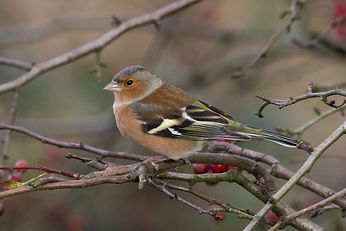
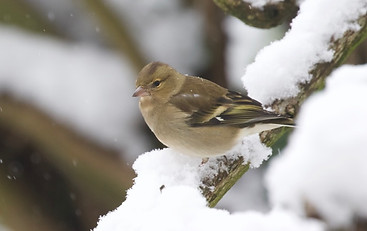
Female

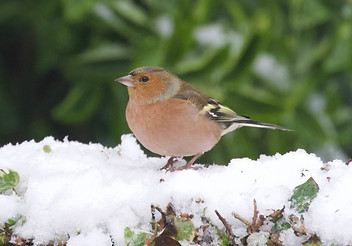
Common Crossbill - Not that rare but quite difficult to find, as they're mainly present during winter and are usually high up in conifer trees. Males are redish all over and the females are greenish in colour. Difficult birds to photograph, as you usually have the camera pointed at the sky. Unless you're lucky enough to encounter them on the ground when they come down for a drink.
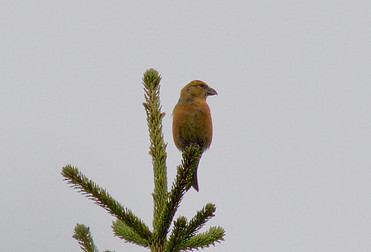
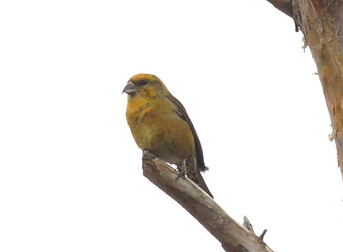
The first photo is a male in the Forest of Dean in February. The others were taken in the Cairngorms in April. 3 & 4 are females.

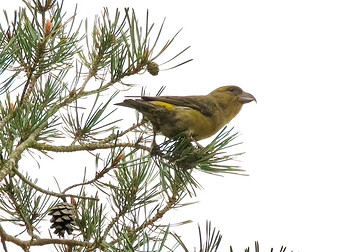
Goldfinch - A bird that wouldn't look out of place in the tropics. Many of us take them for granted as they're one of our commenest birds and frequent visitors to the garden. Put a niger seed feeder out in the winter and you'll be unlucky not to get them visit you. Photos 2 and 4 are very typical views of goldfinch. On teasel heads and thistle down in the autumn.




A winter flock feeding on a mixer seed crop grown for birds
Greenfinch - Another under appreciated bird I think. In fresh, young plumage the males (like photo one (right)), can look stunning. As we don't have many green birds here they are pretty special. Well down in numbers these days though sadly. They love black sunflower seeds in our garden feeders.
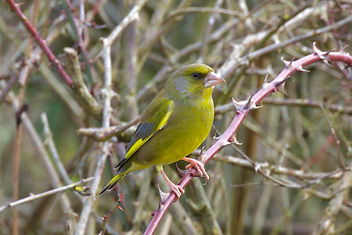



Photos 3&4 show females.
Hawfinch - Our largest finch but one of the most difficult to see. There are certain places that they tend to favour over the winter. Very difficult to see when the trees are in leaf. They tend to like being at the tops of trees. A pretty stunning bird when you are fortunate enough to see them though. They have a huge, heavy duty bill.


Gathering beech mast.
Forest of Dean. March
Lesser Redpoll - Until fairly recently this was one of the harder species of finch for us to see. However in recent years they have become frequent, and very welcome, visitors to our garden. They come to the niger feeder during winter. A tiny finch but quite gutsy. Short, fine, jet black legs. The males pink breast develops through the winter and early spring, ready for the breeding season.


Taken in our garden during March
Linnet - A fairly plain bird for most of the year but the males can turn very red on the breast at breeding time. Not a garden species. They seem to particularly like coastal areas but are fairly widespread. Can form large flocks in winter.


Photo 1 is a male taken on heathland in Dorset, 2 was in upland in Mid-Wales, 3 on the Devon coast and 4 is a female taken on the edge of wetland in Worcs.


A typical winter flock in a large hedgerow
Mealy Redpoll - Rarer than the lesser redpoll. Often found in mixed flocks with lesser, which is how I found these birds (right). Not easy to distinguish. Tend to be a bit plumper and greyer when compared with the browner lesser redpoll. With strongly contrasting bright crimson foreheads and breasts in the males and bolder white wing bars.


Taken in our garden in Jabuary
Serin - A rare bird in Britain. More a Mediterranean species. This image is a cheat really. It was taken in Moraira in Spain when I was on holiday. I found them to be numerous and very approachable indeed. The chances of seeing them in GB are slim, so I couldn't resist including this little fella. They are a small finch. June

Siskin - Attractive small finches The males are particularly striking when you get a good view. Short black legs. Can be confused with greenfinch in a mixed flock, until you get your eye in. Quite a bit smaller though and the male has significant amounts of black on his head and wings.
Both sexes are heavily streaked on the flanks too. They occasionally visit our garden feeding station. Usually during the harsher winters.
Pictures all taken from the main hide at Lake Vyrnwy, a great place to see them close-up. 1&2 are males, 3 female, 4 juvenile.

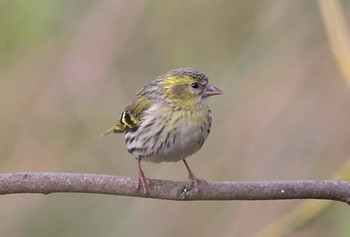


Twite - A real LBJ (Little Brown Jobbie). Very similar to a female linnet, but with a few subtle differences. They have a yellowish bill, a more forked tail, the males have a pink rump and they are slightly smaller and shorter legged.They tend to hug the coast in winter. One of our rarer finches and definitely not one you're likely to see on your bird feeders. The photos here were taken on Shetland where they breed and maintain reasonable numbers.

